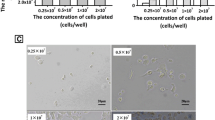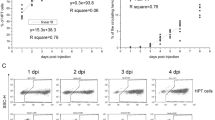Summary
During the course of studies involving the in vitro manipulation of channel catfish peripheral blood leukocytes, spontaneous proliferation was observed with unexpectedly high frequency. Propagation of these spontaneously proliferating cells has resulted in the development of long-term (>11 mo.) cell lines which stain positively for nonspecific esterase and peroxidase, are phagocytic for latex beads, and morphologically resemble mammalian monocytes or macrophages. These long-term cell lines also exhibit two important additional functional features. First, induction with lipopolysaccharide results in the secretion of relatively high levels of catfish high and low molecular weight species of interleukin-1 active on channel catfish and mouse T cells, respectively. Second, these cell lines are efficient antigen-presenting cells to autologous peripheral blood leukocytes for antigen specific in vitro proliferative and antibody responses. This antigen-presenting function is blocked by inhibitors known to prevent antigen processing and presentation by mammalian monocytes. Allogeneic mixtures of cell line (used as antigen-presenting cells) and responding peripheral blood leukocytes, however, resulted in strong mixed leukocyte reaction but not in specific antibody responses. The availability of such cell lines should facilitate further studies on accessory cell functions in fish immune responses.
Similar content being viewed by others
References
Berzofsky, J. A.; Ozaki, S. Antibody conjugates mimic specific B-cell presentation of antigen: epitope restrictions in specific T-B interaction. In: Schook, L. B.; Tew, J. G., eds. Antigen presenting cells: diversity, differentiation and regulation. New York: Alan R. Liss Inc.; 1988:41–48.
Bird, R. C.; Nusbaum, K. E.; Screws, E. A., et al. Molecular cloning of fragments of the channel catfish virus (Herpesviridae) genome and expression of encoded mRNA during infection. Am. J. Vet. Res. 49:1850–1855; 1988.
Blum, J. S.; Creswell, P. Role for intracellular proteases in the processing and transport of class II HLA antigens. Proc. Natl. Acad. Sci. USA 85:3975–3979; 1988.
Bly, J. E.; Miller, N. W.; Clem, L. W. A monoclonal antibody for neutrophils in normal and stressed channel catfish. Dev. Comp. Immunol. 14:211–221; 1990.
Breazile, J. E.; Mass, H. J.; Wollscheid, J., et al. A light and electron microscopic study of the leukocytes of channel catfish (Ictalurus punctatus). Zbl. Vet. Med. C. Anat. Histol. Embryol. 11:107–116; 1982.
Cannon, M. S.; Mollenhauer, H. H.; Eurell, T. E., et al. An ultrastructural study of the leukocytes of the channel catfishIctalurus punctatus. J. Morphol. 164:1–23; 1980.
Clem, L. W.; Sizemore, R. C.; Ellsaesser, C. F., et al. Monocytes as accessory cells in fish immune responses. Dev. Comp. Immunol. 9:803–809; 1985.
Ellsaesser, C. F.; Miller, N. W.; Lobb, C. J., et al. A new method for the cytochemical staining of cells immobilized in agarose. Histochemistry 80:559–562; 1984.
Ellsaesser, C. F. Isolation and characterization of channel catfish high and low molecular weight species of interleukin-1. Jackson, MS: Univ. Mississippi Medical Center; 1990. Thesis.
Ellsaesser, C. F.; Miller, N. W.; Cuchens, M. A., et al. Analysis of channel catfish peripheral blood leukocytes by brightfield microscopy and flow cytometry. Trans. Am. Fish. Soc. 114:271–277; 1985.
Faulman, E.; Cuchens, M. A.; Lobb, C. J., et al. An effective culture system for studying in vitro mitogenic responses of channel catfish lymphocytes. Trans. Am. Soc. Fish. 112:673–679; 1983.
Garrett, L. R.; Bost, K. L.; Buttke, T. M., et al. Changes in the DNA of lymphocytes from pristane-treated rats. Agents Actions 20:104–112; 1987.
Gillis, S.; Scheid, M.; Watson, J. Biochemical and biologic characterization of lymphocyte regulatory molecules. III. The isolation and phenotypic characterization of interleukin-2 producing T cell lymphomas. J. Immunol. 125:2570–2578; 1980.
Gillis, S.; Ferou, M. M.; You, W., et al. T cell growth factor: parameters of production and a quantitative microassay for activity. J. Immunol. 120:2027–2032; 1978.
Gillis, S.; Mizel, S. B. T-cell lymphoma model for the analysis of interleukin-1 mediated T-cell activation. Proc. Natl. Acad. Sci. USA 78:1133–1137; 1981.
Glimcher, L. H.; Kim, K. J.; Green, I., et al. Ia antigen-bearing B cell tumor lines can present protein antigen and alloantigen in a major histocompatibility complex-restricted fashion to antigen-reactive T cells. J. Exp. Med. 155:445–459; 1982.
Gronowicz, E. S.; Doss, C. A.; Howard, F. D., et al. An in vitro line of B cell tumor BCL1 can be activated by LPS to secrete IgM. J. Immunol. 125:976–980; 1980.
Hayhoe, F. G. H.; Flemans, R. J. Color atlas of hematological cytology, 2nd ed. New York: John Wiley & Sons; 1982.
Hoffman, R. A.; Kung, P. C.; Hansen, W. P., et al. Simple and rapid measurement of human T lymphocytes and their subclasses in the peripheral blood. Proc. Natl. Acad. Sci. USA 77:4914–4917; 1980.
Horibata, K.; Harris, A. W. Mouse myelomas and lymphomas in culture. Exp. Cell Res. 60:61–77; 1970.
Kohler, G.; Milstein, C. Continuous cultures of fused cells secreting antibody of predefined specificity. Nature 256:495–497; 1971.
Koren, H. S.; Handwerger, B. S.; Wunderlich, J. R. Identification of macrophage-like characteristics in a cultured murine tumor line. J. Immunol. 114:894–897; 1975.
Kripke, M. L.; Weiss, D. W. Studies on the immune responses of BALB/c mice during tumor induction by mineral oil. Int. J. Cancer 6:422–430; 1970.
Lechler, R. I.; Lombardi, G.; Batchelor, J. R., et al. The molecular basis of alloreactivity. Immunol. Today 11:83–88; 1990.
Lepe-Zuniga, J. L.; Zigler, J. S.; Zimmerman, M. L., et al. Differences between intra- and extracellular interleukin-1. Mol. Immunol. 221:1387–1392; 1985.
Machamer, C. E.; Creswell, P. Monensin prevents terminal glycosylation ofN- andO-linked oligosaccharides of the HLA-DR associated invariant chain and inhibits its dissociation from theα-β chain complex. Proc. Natl. Acad. Sci. USA 81:1287–1291; 1984.
Mahajan, C. L.; Dheer, J. M. S. An autoradiographic and cytochemical study of erythropoeisis inChanna punctatus. J. Fish Biol. 17:641–648; 1980.
Miller, N. W.; Sizemore, R. C.; Clem, L. W. Phylogeny of lymphocyte heterogeneity: the cellular requirements for in vitro antibody responses of channel catfish leukocytes. J. Immunol. 134:2884–2888; 1985.
Miller, N. W.; Bly, J. E.; van Ginkel, F., et al. Phylogeny of lymphocyte heterogeneity: Identification and separation of functionally distinct subpopulations of channel catfish lymphocytes with monoclonal antibodies. Dev. Comp. Immunol. 11:739–747; 1987.
Miller, N. W.; Deuter, A.; Clem, L. W. Phylogeny of lymphocyte heterogeneity: the cellular requirement for the mixed leucocyte reaction with channel catfish. Immunology 59:123–128; 1986.
Miller, N. W.; Clem, L. W. Microsystem for in vitro primary and secondary immunization of channel catfish (Ictalurus punctatus) leucocytes with hapten-carrier conjugates. J. Immunol. Methods 72:367–379; 1984.
Miller, N. W.; Clem, L. W. A culture system for mitogen-induced proliferation of channel catfish (Ictalurus punctatus) peripheral blood lymphocytes. J. Tissue Cult. Methods 11:69–73; 1988.
Mizel, S. B.; Rosenstreich, D. L. Regulation of lymphocyte activating factor (LAF) production and secretion in P388D1 cells. Identification of high molecular weight precursors of LAF. J. Immunol. 122:2173–2179; 1979.
Nusbaum, K. E.; Grizzle, J. M. Uptake of channel catfish virus from water by channel catfish and bluegills. Am. J. Vet. Res. 48:375–377; 1987.
Papadimitriou, J. M.; Ashman, R. B. Macrophages: current views on their differentiation, structure and function. Ultrastruct. Pathol. 13:343–372; 1989.
Ryser, J. E.; Robson MacDonald, H. Limiting dilution analysis of alloantigen-reactive T lymphocytes. I. Comparison of precursor frequencies for proliferative and cytolytic responses. J. Immunol. 122:1691–1696; 1979.
Sanders, S. K.; Alexander, E. L.; Braylan, R. C. A high yield technique for preparing cells fixed in suspension for scanning electron microscopy. J. Cell Biol. 67:476–480; 1975.
Sizemore, R. C.; Miller, N. W.; Cuchens, M. A., et al. Phylogeny of lymphocyte heterogeneity: the cellular requirement for the in vitro mitogenic responses of channel catfish leucocytes. J. Immunol. 133:2920–2924; 1984.
Skinner, M. A.; Malbrook, J. An estimation of the frequency of precursor cells which generate cytotoxic lymphocytes. J. Exp. Med. 143:1562–1567; 1976.
Sun, T.; Li, C. Y.; Yam, L. T. Atlas of cytochemistry and immunocytochemistry of hematologic neoplasms. Chicago: American Society of Clinical Pathology Press; 1985.
Vallejo, A. N.; Miller, N. W.; Jorgensen, T., et al. Phylogeny of immune recognition: antigen processing/presentation in channel catfish immune responses to hemocyanins. Cell. Immunol. 130:364–377; 1990.
Wise, J. A.; Harrell, S. F.; Busch, R. L., et al. Vertical transmission of channel catfish virus. Am. J. Vet. Res. 49:1506–1509; 1988.
Ziegler, H. K.; Unanue, E. R. Decrease in macrophage antigen catabolism caused by ammonia and chloroquine is associated with inhibition of antigen presentation to T cells. Proc. Natl. Acad. Sci. USA 79:175–178; 1982.
Author information
Authors and Affiliations
Additional information
This work was supported in part by grant 5-R37-AI-19530 from the National Institutes of Health, Bethesda, MD.
Rights and permissions
About this article
Cite this article
Vallejo, A.N., Ellsaesser, C.F., Miller, N.W. et al. Spontaneous development of functionally active long-term monocytelike cell lines from channel catfish. In Vitro Cell Dev Biol - Animal 27, 279–286 (1991). https://doi.org/10.1007/BF02630904
Received:
Accepted:
Issue Date:
DOI: https://doi.org/10.1007/BF02630904




